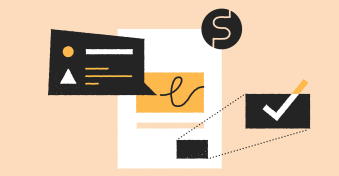The contract period is one of the most critical provisions in any agreement.
While some contracts remain in place indefinitely, others have a strict expiration date.
Renewing contracts allows businesses to extend commercial relationships, renegotiate terms, and address changes in a timely manner.
Auto-renewal can ensure your contract renewal process goes smoothly, avoiding delays in the provision of goods and services (and associated financial impacts). But it requires a proper workflow.
Read on to learn about the contract renewal process.
Key takeaways
- Contract renewal is extending the duration of a contract beyond the original expiration date, either automatically or through a manual renewal process.
- Renewing contracts ensures continuity of business relationships, financial stability, risk mitigation, and opportunities to renegotiate and make improvements to the original contract.
- Automatic renewal provisions can save time, ensure uninterrupted service, and guarantee revenue.
- Contract lifecycle management (CLM) is essential for efficiently tracking contracts, finding renewal opportunities, and never missing renewal dates.
- With features like automated reminders and contract templates, contract management software can streamline the contract renewal process.
What is contract renewal?
When a contract is set to expire, the initial term of the contract can be renewed (or extended) to keep the contract in force.
Contract renewal ensures continuity of the contractual relationship between parties. It can happen:
- Automatically according to the terms of the contract itself; or
- Manually based on the renegotiation of the current contract.
When renewing a contract, parties may either continue with the terms of the existing contract or negotiate amendments.
How can I know when my contract will expire?
There’s no hard-and-fast rule for where information appears about when a contract expires.
Commercial contracts, like non-disclosure agreements and equipment rental agreements, typically define the length of the contract’s terms in a section called DURATION OF TERMS. Simple contracts may state their duration at the very beginning.
Here’s an example of a contract renewal clause from our copyright license agreement template:
“This Agreement will commence on [date] (the “Effective Date”) and continue until [date] (the “Termination Date”) or until either party provides written notice of termination to the other party with a [number of days] notice.”

Copyright License Agreement Template
Used 7328 times
Use this Copyright License Agreement to authorize others to use your intellectual property.
Use this templateIn this example, the renewal clause is placed directly under the identification clause and in the same paragraph as the governing law clause.
A termination notice period clause is also present.
Typically, a contract will stipulate a renewal notice period. Some US states require businesses to notify clients of contract renewal (usually 30 days in advance). Other states, like Indiana and Idaho, require no renewal notice period.
At PandaDoc, we give a renewal notice period of 90 days in order to be proactive and ensure smooth engagement with our customers.
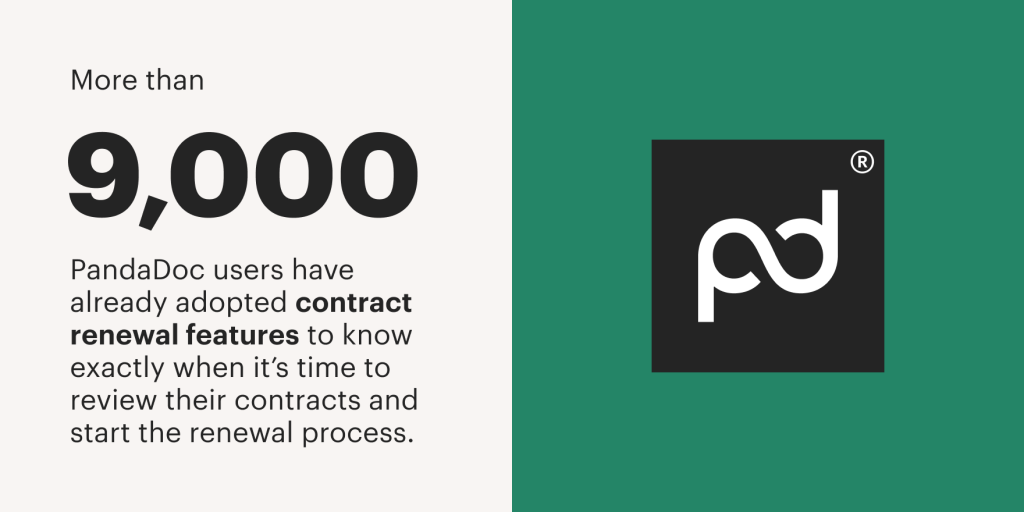
What’s the difference between renewing and extending a contract?
The terms renewal and extension are often used interchangeably, but contract extension is different from contract renewal. In fact, in a case decided before the Tennessee Supreme Court1, ambiguity as to whether the terms renew and renewal within a contract referred to an extension had real financial consequences.
The justices decided that BSG did not owe residual fees to Check Velocity on the grounds that a contract between the companies signed in 2006 was not a renewal of the original contract signed in 2004.
While contract renewals present the opportunity to improve existing contracts and meet the goals of contract stakeholders, extensions simply extend the existing terms of the contract, without the need to create a new agreement.
Contract extension is a good idea if an agreement governs a specific, term-limited project that needs more time to be completed.
Contract renewal is a good idea if companies are satisfied with the current business relationship and want to continue working together for another fixed period of time. For example, a contract may be renewed annually.
How can businesses renew contracts?
The contract renewal process extends the validity of a contractual relationship that would otherwise expire.
The manual contract renewal process usually looks like this:
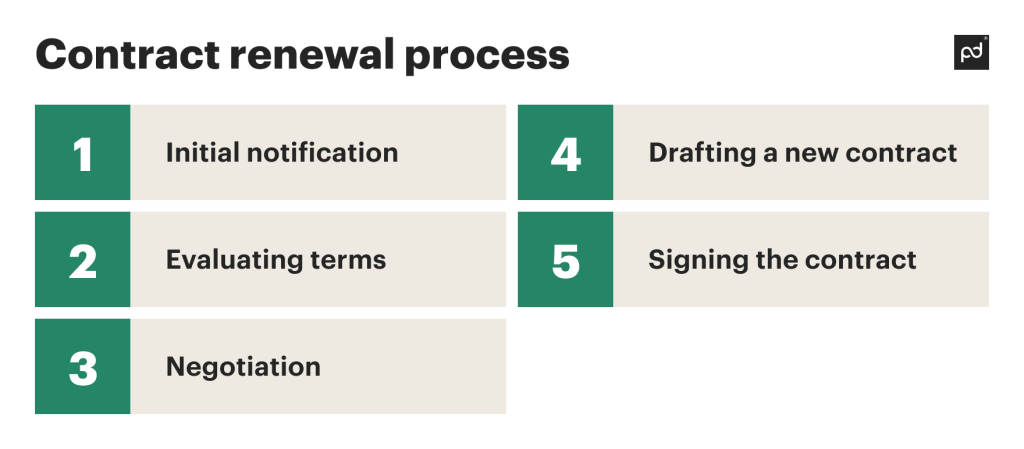
- Initial notification: One party notifies the other of the upcoming contract expiration.
- Evaluating terms: Both parties review existing contract terms and obligations.
- Negotiation: If needed, the parties agree on new terms or changes to existing terms.
- Drafting a new contract: Once both parties come to an agreement, they draft a new contract, keeping the previous terms or making changes.
- Signing the contract: Parties sign the contract, making it legally valid.
A contract can be renewed manually (with or without the assistance of contract automation tools) or entirely automatically according to renewal provisions in the contract itself.
Each approach has its advantages, though in most cases, automatic renewal is the better option.
Why consider manual contract renewal?
Traditional manual contract renewal relies on emails, spreadsheets, and decentralized contract databases.
Thankfully, contract management software can help you automate parts of the renewal process — for example, reviewing large volumes of contracts with different expiration dates and terms.
Manual contract renewal can sometimes be beneficial, as it can result in:
1. Strong business relationships
If you maintain business relationships by discussing agreement terms annually, you likely won’t have to look for new partners and spend time on procurement.
Plus, old customers are more likely to negotiate and offer more favorable contract terms than new partners.
2. Contract lifecycle management
Setting up contract management processes and a contract repository (often with the help of contract management software) is an essential part of any contracting process but is critical when manually renewing contracts.
According to the Aberdeen Group, businesses that have strong contract management processes are:
- More likely to manage their contract costs;
- More likely to reduce overall business risk;
- More likely to receive higher reviews;
- Less likely to lose clients during a renewal;
- Less likely to receive complaints;
- Less likely to fail in the negotiation stage.
3. Finding renewal opportunities
During a manual renewal process, you may find opportunities for improvement.
For example, if your sales team has made billing-related changes, you may want to renegotiate how clients pay their invoices.
If you do choose to review contracts manually, understand that you must have a solid process in place to achieve scalable success.
Why is auto-renewal best in most cases?
Business owners can benefit from contracts that auto-renew in various ways:
No business interruptions
Automatic renewal provisions mean parties can continue providing and receiving goods and services without interruption.
Less negotiation
If you’re happy with the current terms of your existing contracts, there’s no need to renegotiate them.
You can simply allow them to automatically renew.
Guaranteed revenue
Manual renewal leaves you open to business interruptions and possible revenue losses if a contract expires before you agree on renewal terms.
When your contracts renew automatically, you’re guaranteed continual revenue without relying on your sales team.
Easier forecasting
With automatic contract renewal, your team can reliably forecast revenue from loyal clients because they won’t have to worry about contract termination.
Less time and hassle
When contracts renew automatically, you don’t need to spend time reviewing existing contracts and signing additional documents.
Do I receive a new contract after renewal?
In most cases, you will receive a new contract after renewal.
For example, a mobile provider will auto-renew your cell phone contract if you pay month to month.
When this happens, even if the costs and terms of service stay the same, a new contract is created.
Risks of contract renewal
Whether contracts are renewed manually or automatically, every contract renewal process involves risk management.
Renewing a contract comes with these risks:
- Loss of customers: Not listening to customers’ needs when renewing contracts might make customers dissatisfied and lead to loss of cooperation.
- Missed opportunities: Not renewing contracts in a timely manner can result in delays to project timelines, the need to quickly replace vital resources, loss of access to favorable prices, and the end of meaningful partnerships.
Managing and mitigating contract renewal risks involves detailed planning and preparation, an established contract management system, and effective communication with customers.
10 tips for an effective contract management workflow
A well-designed contract workflow is the best way to prepare for contract renewal and find renewal opportunities.
Here are some best practices to make your contract renewal strategy effective.
1. Don’t put off a contract review until it’s time to renew
Don’t put your renewal process on the back burner or you could miss out on opportunities to negotiate new terms.
In 2023, PandaDoc users relied on the auto reminders feature for 163,572 more agreements than in 2022.
Getting timely renewal reminders for all your contracts helps you avoid being locked into contracts with unfavorable terms and ensures you are ready to suggest changes when the time arrives.
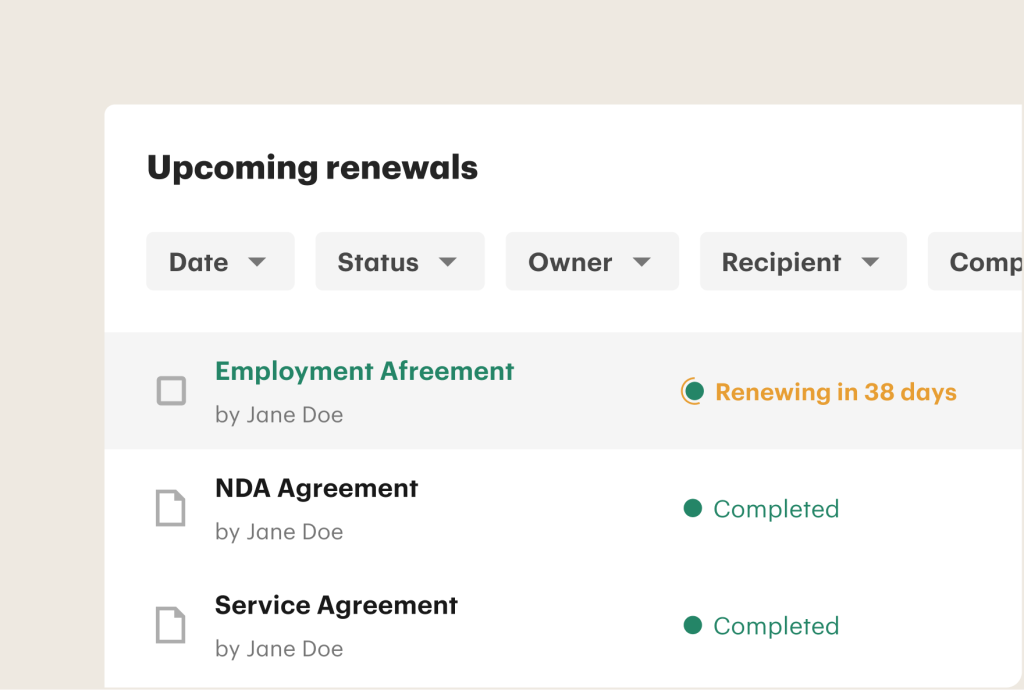
2. Have a library of contract templates and terms
Start by categorizing contracts based on their type (service agreements, vendor contracts, employment agreements, etc.).
Develop standardized templates for each contract type and regularly review and update these templates to reflect changes in laws, regulations, and industry standards.
You can rely on software like PandaDoc to store templates so they are easy to find and use.
When maintaining templates, ensure flexibility by accounting for adding or removing clauses or sections based on specific contract requirements.
3. Communicate with your partners and employees
In addition to negotiating with your business partners, don’t forget to speak to your employees during the contract renewal process.
Your employees interact with your customers daily and may be able to offer unique insights on how to improve your processes or your relationships with partners.
4. Consult with a legal team to improve your contracts
Contract management comes with a lot of legal red tape.
You need to follow contract law, include the essential elements of a contract, and avoid vitiating factors that could make your contracts invalid.
Keeping an attorney on retainer isn’t cost-effective for most small businesses, but you can pay a contract lawyer hourly to review existing documents to ensure they protect you and your clients.
You can also use PandaDoc to track changes and include those responsible for approval in the workflow.
When reviewing modifications to an existing template, tracking changes may save time for an attorney or legal team.
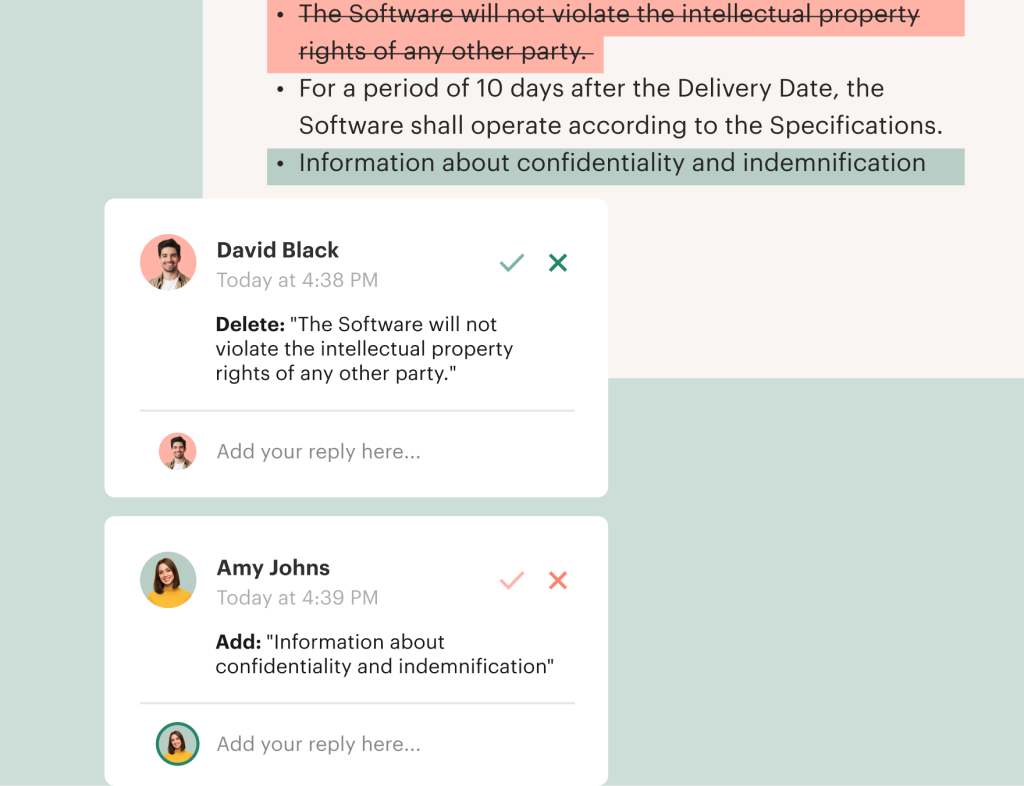
5. Automate data collection and tracking
Collecting and monitoring data is increasingly important to support business growth and monitor contract performance.
Companies use customer relationship management (CRM) or sales pipeline software to automatically track important metrics such as lead time and cost per acquisition.
These are some tips on how you can automate contract-related data collection and tracking:
- Use dedicated software to manage all contracts, ensuring easy access to contract details and automated data tracking.
- Set up automated reminders to notify responsible parties of upcoming renewals, preventing missed deadlines.
- Leverage the power of contract templates and configure auto-renewal provisions.
- Develop workflows to automate approval processes, sending contracts to responsible personnel for review and authorization.
- Add analytics tools to easily track, access, and analyze contract data. You may also want to add automatic reporting features, allowing you to gain insights into renewal trends, performance metrics, and potential risks.
- Use electronic signature software powered by robust document management features to expedite the signing process, and rest assured that all contracts are securely stored and easily retrievable.
6. Share contracts securely
Securing a contract means preventing others from seeing it, manipulating it, or sending it to people who shouldn’t have access.
It’s common for clients and business owners to send contracts by email, but this is actually one of the least secure methods of transmitting information.
One way to ensure that no one gains access to your files is by using the PandaDoc eSignature tool, which allows you to send documents via an encrypted channel and only allows access to authorized parties.
7. Build a contract repository
Consider using a contract repository to have a bird’s-eye view of all contracts, including details like terms, dates, and obligations for each agreement.
A contract repository helps you securely store data, enables automated document version tracking, allows instant document access, and automates several steps in the contract lifecycle, from creation to renewal.
This is what a contract repository looks like in PandaDoc:
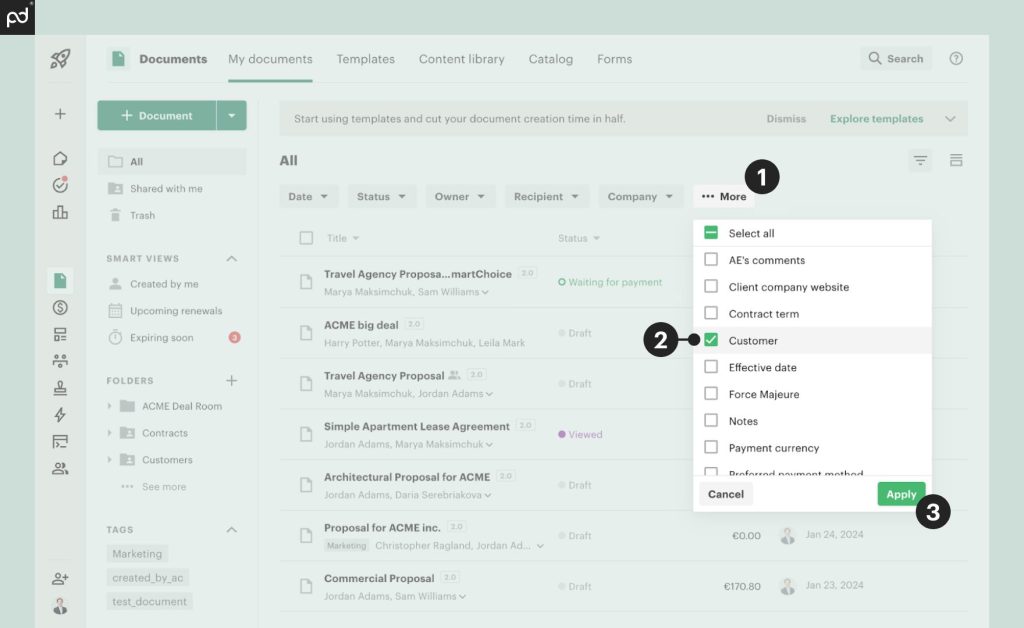
8. Hold monthly/yearly reviews
Irrespective of contract renewal dates, consider holding either monthly or yearly contract reviews.
This helps you decide in advance whether you would like to review a contract and, if yes, what changes have to be made before the renewal date.
9. Standardize the process
Have a standardized procedure for contract renewals.
This could be especially useful in cases where the person responsible for renewals leaves on vacation and contract due dates are approaching.
You can write our detailed steps for your company’s contract renewal process, create a Loom video to share details, and keep all contract templates in one place for convenience.
10. Assign roles
When various parties are involved in the contract renewal process, make sure everyone knows what tasks they are responsible for.
If you don’t want to turn contract renewal into a brainstorming session, consider assigning specialists responsible for:
- Drafting contracts
- Checking and approving terms
- Negotiating new changes with clients or vendors
- Managing renewals
Streamline contract renewal with PandaDoc
We’ve just looked at how you can develop the best contract renewal workflow.
Contract renewal management is necessary to:
- Have a centralized contract repository;
- Have an effective way to track agreements;
- Save time and money;
- Never miss a renewal date;
- Never lose a contract.
As contract creation, e-signing, and contract management software, PandaDoc acts as a digital repository for all your contracts and simplifies your contract management workflow.
The platform’s contract renewal automation functionality allows you to streamline contract lifecycle management by keeping track of upcoming expiration dates and sending notifications to responsible parties.
You can also include automatic renewal provisions in your contracts to avoid the hassles of manual renewal and ensure there are no interruptions to your business relationships.
Disclaimer
PandaDoc is not a law firm, or a substitute for an attorney or law firm. This page is not intended to and does not provide legal advice. Should you have legal questions on the validity of e-signatures or digital signatures and the enforceability thereof, please consult with an attorney or law firm. Use of PandaDocs services are governed by our Terms of Use and Privacy Policy.
Originally published June 6, 2022, updated July 17, 2024

